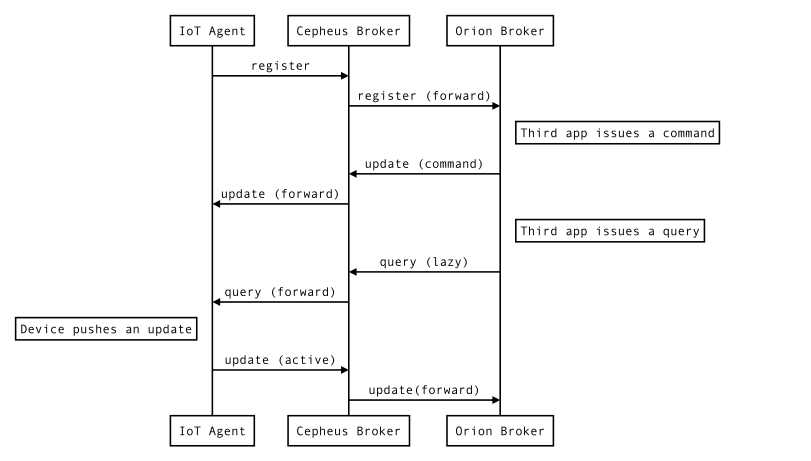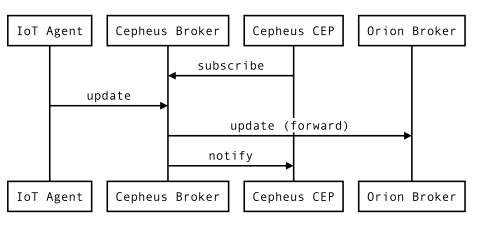Introduction
The Cepheus-broker component is a lightweight broker only supporting two kinds of operations:
- requests forwarding by keeping track of which components register Context Entities.
- pub/sub requests for Context Entities.
This keeps the implementation simple and sufficient for the use cases handled by the NGSI gateway.
The main goal of the Cepheus-Broker is to sit between the "south components" like IoT Agents or NGSI devices (actuators and sensors), forward their requests to a remote broker (e.g. a "north component" like Orion) while allowing some other NGSI components (like the Cepheus-CEP) to subscribe to some the updated Context Elements.

Forwarding support
Request forwarding is based on the fact that south components (like IoT Agents and NGSI devices) will register their Context Entities on startup.
The broker will track these /registerContext requests (keeping a list of all providingApplication URLs)
before forwarding them back to the remote broker.
Then when /updateContext or /queryContext requests arrive, they will be :
- either forwarded to south components when a matching providingApplication URL is found.
- else forwarded to the remote broker.

The forwarding process is described in the Fiware-Orion project documentation: here
Disable updateContext forward to the remote broker
In some complex scenarios, it might be useful to hide Context Entities updates emitted by "south components" like sensors from the remote broker for privacy, latency or security reasons.
The forwarding of updateContext requests to the remote broker can be disabled
by setting remote.forward.updateContext to false
(see admin guide for more details).
Pubsub support
Publish/subscribe is supported by the /subscribeContext requests to Context Entities that will trigger /notifyContext requests.
This feature is mainly used by Cepheus-CEP to track updates to Context Entities.

The subscriptions are persisted in a Sqlite database.
Limitations
The broker has many limitations due to its simple design compared to a complete broker implementation.
- Broker supports all NGGSI-10 standard and convenient operations from the NGSI v1 API except for the 'updateContextSubscriptions' operation.
- Broker only support the NGSI-9
registerContextoperation from the NGSI v1 API for request forwarding. - Subscriptions only support
ONCHANGEas type of notification ofnotifyCondition. - Subscriptions do not support
throttling,restrictionorcondValues. - Subscriptions will send the whole set of updated context elements in the payload notification, there is no filtering.
- If multiple NGSI providers register the same Context Entities, only the first provider will get the forwarded
queryContextorupdateContextrequests. - When a
queryContextorupdateContextrequest contains references to multiple Context Entities, the request is forwarded only to the Context Provider of the first Context Entity. - Broker does not keep the any value of Context Entities, all requests will get forwarded to a Context Provider or the remote Broker.